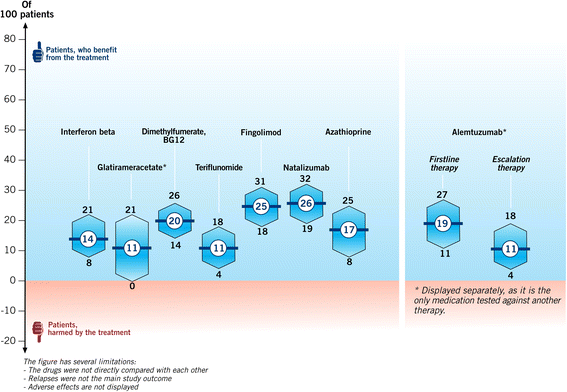Comprehension of confidence intervals - development and piloting of patient information materials for people with multiple sclerosis: qualitative study and pilot randomised controlled trial
- PMID: 27650788
- PMCID: PMC5029009
- DOI: 10.1186/s12911-016-0362-8
Comprehension of confidence intervals - development and piloting of patient information materials for people with multiple sclerosis: qualitative study and pilot randomised controlled trial
Abstract
Background: Presentation of confidence intervals alongside information about treatment effects can support informed treatment choices in people with multiple sclerosis. We aimed to develop and pilot-test different written patient information materials explaining confidence intervals in people with relapsing-remitting multiple sclerosis. Further, a questionnaire on comprehension of confidence intervals was developed and piloted.
Methods: We developed different patient information versions aiming to explain confidence intervals. We used an illustrative example to test three different approaches: (1) short version, (2) "average weight" version and (3) "worm prophylaxis" version. Interviews were conducted using think-aloud and teach-back approaches to test feasibility and analysed using qualitative content analysis. To assess comprehension of confidence intervals, a six-item multiple choice questionnaire was developed and tested in a pilot randomised controlled trial using the online survey software UNIPARK. Here, the average weight version (intervention group) was tested against a standard patient information version on confidence intervals (control group). People with multiple sclerosis were invited to take part using existing mailing-lists of people with multiple sclerosis in Germany and were randomised using the UNIPARK algorithm. Participants were blinded towards group allocation. Primary endpoint was comprehension of confidence intervals, assessed with the six-item multiple choice questionnaire with six points representing perfect knowledge.
Results: Feasibility of the patient information versions was tested with 16 people with multiple sclerosis. For the pilot randomised controlled trial, 64 people with multiple sclerosis were randomised (intervention group: n = 36; control group: n = 28). More questions were answered correctly in the intervention group compared to the control group (mean 4.8 vs 3.8, mean difference 1.1 (95 % CI 0.42-1.69), p = 0.002). The questionnaire's internal consistency was moderate (Cronbach's alpha = 0.56).
Conclusions: The pilot-phase shows promising results concerning acceptability and feasibility. Pilot randomised controlled trial results indicate that the patient information is well understood and that knowledge gain on confidence intervals can be assessed with a set of six questions.
Trial registration: German Clinical Trials Register: DRKS00008561 . Registered 8th of June 2015.
Keywords: Confidence interval; Interview; Multiple sclerosis; Patient information; Pilot randomised controlled trial.
Figures
Similar articles
-
Nurse-led immunotreatment DEcision Coaching In people with Multiple Sclerosis (DECIMS) - Feasibility testing, pilot randomised controlled trial and mixed methods process evaluation.Int J Nurs Stud. 2018 Feb;78:26-36. doi: 10.1016/j.ijnurstu.2017.08.011. Epub 2017 Aug 26. Int J Nurs Stud. 2018. PMID: 28982479 Clinical Trial.
-
Comprehension of confidence intervals in audio-visual patient information materials for people with multiple sclerosis (COCO-MS): A web-based randomised controlled, parallel group trial.Patient Educ Couns. 2021 May;104(5):1132-1139. doi: 10.1016/j.pec.2020.09.035. Epub 2020 Sep 29. Patient Educ Couns. 2021. PMID: 33054984 Clinical Trial.
-
Structured, intensive education maximising engagement, motivation and long-term change for children and young people with diabetes: a cluster randomised controlled trial with integral process and economic evaluation - the CASCADE study.Health Technol Assess. 2014 Mar;18(20):1-202. doi: 10.3310/hta18200. Health Technol Assess. 2014. PMID: 24690402 Free PMC article. Clinical Trial.
-
Knowledge and worries on motherhood choice in multiple sclerosis - a cross-sectional study on patient-reported outcome measures.Mult Scler Relat Disord. 2023 Aug;76:104789. doi: 10.1016/j.msard.2023.104789. Epub 2023 Jun 4. Mult Scler Relat Disord. 2023. PMID: 37327598
-
Systematic reviews of the effectiveness of day care for people with severe mental disorders: (1) acute day hospital versus admission; (2) vocational rehabilitation; (3) day hospital versus outpatient care.Health Technol Assess. 2001;5(21):1-75. doi: 10.3310/hta5210. Health Technol Assess. 2001. PMID: 11532238 Review.
Cited by
-
Up-to-date knowledge about the association between multiple sclerosis and the reactivation of human endogenous retrovirus infections.J Neurol. 2018 Aug;265(8):1733-1739. doi: 10.1007/s00415-018-8783-1. Epub 2018 Feb 8. J Neurol. 2018. PMID: 29423611
-
Mycophenolate mofetil withdrawal in patients with systemic lupus erythematosus: a multicentre, open-label, randomised controlled trial.Lancet Rheumatol. 2024 Mar;6(3):e168-e177. doi: 10.1016/S2665-9913(23)00320-X. Epub 2024 Jan 29. Lancet Rheumatol. 2024. PMID: 38301682 Free PMC article. Clinical Trial.
-
"I Will Respect the Autonomy of My Patient": A Scoping Review of Shared Decision Making in Multiple Sclerosis.Int J MS Care. 2020 Nov-Dec;22(6):285-293. doi: 10.7224/1537-2073.2020-027. Epub 2020 Dec 28. Int J MS Care. 2020. PMID: 33424485 Free PMC article.
-
Impact of a multimedia website with patient experiences of multiple sclerosis (PExMS) on immunotherapy decision-making: study protocol for a pilot randomised controlled trial in a mixed-methods design.Pilot Feasibility Stud. 2021 Jan 7;7(1):16. doi: 10.1186/s40814-020-00749-0. Pilot Feasibility Stud. 2021. PMID: 33413658 Free PMC article.
-
Information provision for people with multiple sclerosis.Cochrane Database Syst Rev. 2018 Oct 14;10(10):CD008757. doi: 10.1002/14651858.CD008757.pub3. Cochrane Database Syst Rev. 2018. PMID: 30317542 Free PMC article.
References
-
- Higgins JPT, Green S, editors. Cochrane handbook for systematic reviews of interventions. Chichester: Wiley-Blackwell; 2011.
-
- Dobbins M. Understanding research evidence. http://www.nccmt.ca/resources/multimedia-eng.html#. Accessed 01 Oct 2015.
Publication types
MeSH terms
Associated data
LinkOut - more resources
Full Text Sources
Other Literature Sources
Medical




